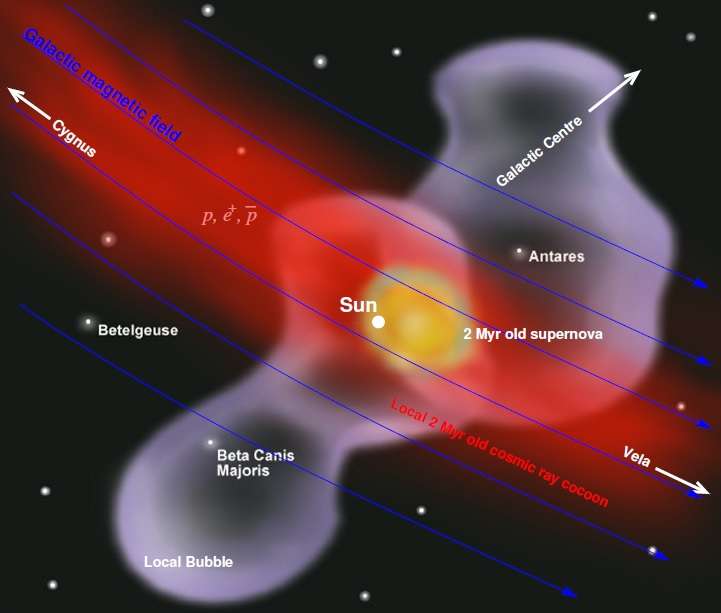November 6, 2015 feature
Observed cosmic rays may have come from two-million-year-old supernova

(Phys.org)—High-energy protons, nuclei, and other particles are constantly showering down on Earth's atmosphere from space, but the origins of these cosmic rays is unknown. One possibility is that the cosmic rays come from supernovae, although the evidence for this claim is limited. Now by analyzing the cosmic ray energy spectrum, scientists have been able to deduce that some high-energy cosmic rays may have originated from a two-million-year-old supernova located roughly 100 trillion miles away.
The existence of such a supernova is also intriguing because, in unrelated work, a supernova of the same age and distance has been proposed as the source of rare iron isotopes buried in the Earth's ocean crusts. The two different sets of data—cosmic rays and iron isotopes—both seem to point to the same exploding star as their source.
The scientists, Michael Kachelrieß, et al., have published a paper on the signatures of supernova in cosmic ray spectra in a recent issue of Physical Review Letters.
As the researchers explain, it's difficult to extract information about the sources of cosmic rays from observations. This is partly because the galactic magnetic field that permeates empty space interferes with the cosmic ray trajectories, which makes the cosmic ray energy intensity nearly uniform. In addition, there are likely multiple sources of cosmic rays, and the signals from all of these sources overlap in the cosmic ray spectrum, which makes it difficult to extract signatures of individual sources.
Despite these challenges, the researchers explain that the cosmic ray energy spectrum may still have some "memory" of individual sources, which could be encoded in small features. The researchers specifically focused on some of the puzzling features, such as why there are more than expected positrons (antielectrons) above a certain energy level. While these features appear puzzling from the standard perspective of cosmic rays and are often ignored, accounting for them is key for identifying the supernova as a cosmic ray source.
"Traditionally in cosmic ray physics, one uses the approximation that the sources of cosmic rays are smoothly distributed in time and space," Kachelrieß, a physics professor at the Norwegian University of Science and Technology in Trondheim, told Phys.org. "Our paper and the related work show that this approximation should be abandoned. For the understanding of many physical phenomena, it is important to take into account that cosmic rays are accelerated in events which happen only about once per century in our galaxy."
The data also provide a way to constrain the parameters of this source: a source that was older or younger than about two million years, or a source that was nearer or further away than 100 trillion miles, would be inconsistent with the observed spectra. One possibility that the data rules out, for example, is that these high-energy cosmic rays originated from a "superbubble," which is a region of space that is "blown" by massive star formation and large numbers of supernovae. The only plausible model of the cosmic ray source, according to the data, is an individual supernova.
"We are continuing to refine our model for the cosmic ray propagation, extending it, for example, to lower energies," Kachelrieß said. "This may have also an impact on the predictions of antimatter fluxed from dark matter annihilations or decays. Moreover, we will try with collaborators to calculate the effect of cosmic rays from this local supernova on the Earth's atmosphere."
More information: M. Kachelrieß, et al. "Signatures of a Two Million Year Old Supernova in the Spectra of Cosmic Ray Protons, Antiprotons, and Positrons." Physical Review Letters. DOI: 10.1103/PhysRevLett.115.181103
Journal information: Physical Review Letters
© 2015 Phys.org



















